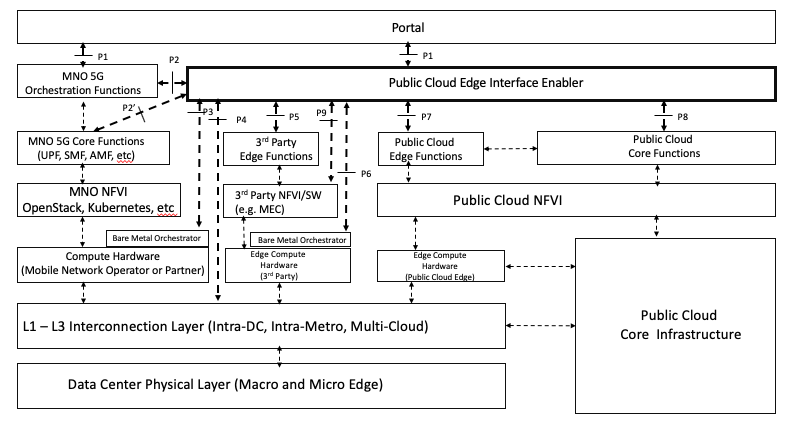...
The PCEI Reference Architecture and the Interface Reference Points (IRP) are shown in the figure below. Note the this figure also provides a component layer view of the PCEI Architecture:
The PCEI Reference Architecture layers are described below:
The PCEI Data Center (DC) Physical Layer belongs to the DCF Domain and provides the physical DC infrastructure located in appropriate geographies (e.g. Metropolitan Areas). It is assumed that the Public Cloud Core infrastructure is interfaced to the PCEI DC Physical Layer through the PCEI L1-L3 Interconnection layer.
The PCEI L1-L3 Interconnection Layer belongs to the ICE Domain and provides physical and logical interconnection and networking functions to all other components of the PCEI architecture.
Within the MNO Domain, the PCEI Reference Architecture includes the following layers:
- Compute Hardware. This include Compute, Network and Storage resources that support MNO functions. Note that the PCEI Reference Architecture recognizes a model, where a MNO has the ability to distribute the compute infrastructure in appropriate locations in the DCF Domain in order to satisfy performance and functional requirements for the targeted application use cases. For example, a MNO may wish to implement a Local Break-Out (LBO) in locations that are geographically closer to the mobile subscribers, and uses compute hardware provided by a qualified Bare Metal service provider.
- The PCEI Architecture further recognizes a model, where the Compute Hardware layer is accessible via the Bare Metal Orchestrator that enables dynamic instantiation of compute/network resources for the MNO functions.
- Network Function Virtualization Infrastructure (NFVI). This is the virtualization layer (e.g. OpenStack, Kubernetes) that may be specific to MNO requirements and provides the ability to support MNO functions such as the 5GC User Plane Function (UPF).
- MNO Core Functions. This layer corresponds to the key MNO Core functions applicable to the PCEI. These functions include (but not limited to): UPF, SMF and other applicable 4G vEPC and 5G Core functions.
- MNO Orchestration Functions. These functions are responsible for communicating the MNO service/performance requirements to the PCEI Enabler and for orchestrating services within the MNO Domain. Examples of these functions include NSSF, NRF, etc.
Objectives
...
